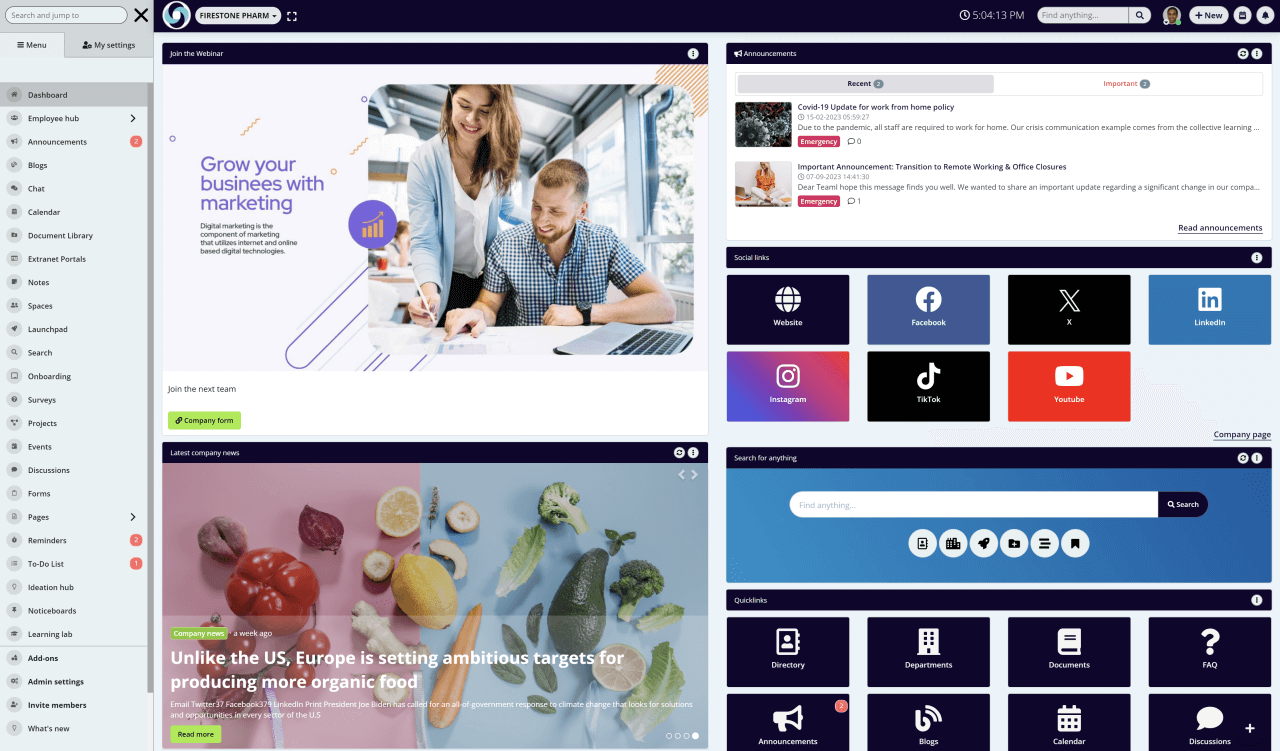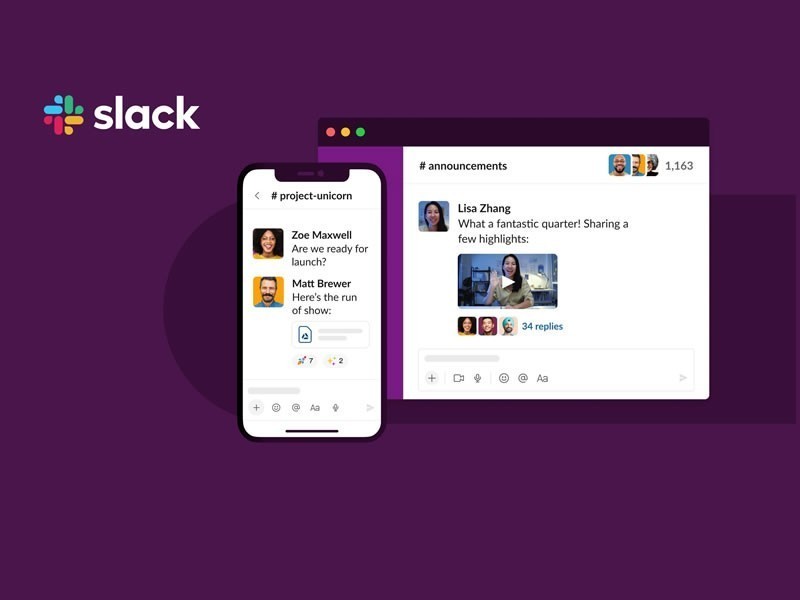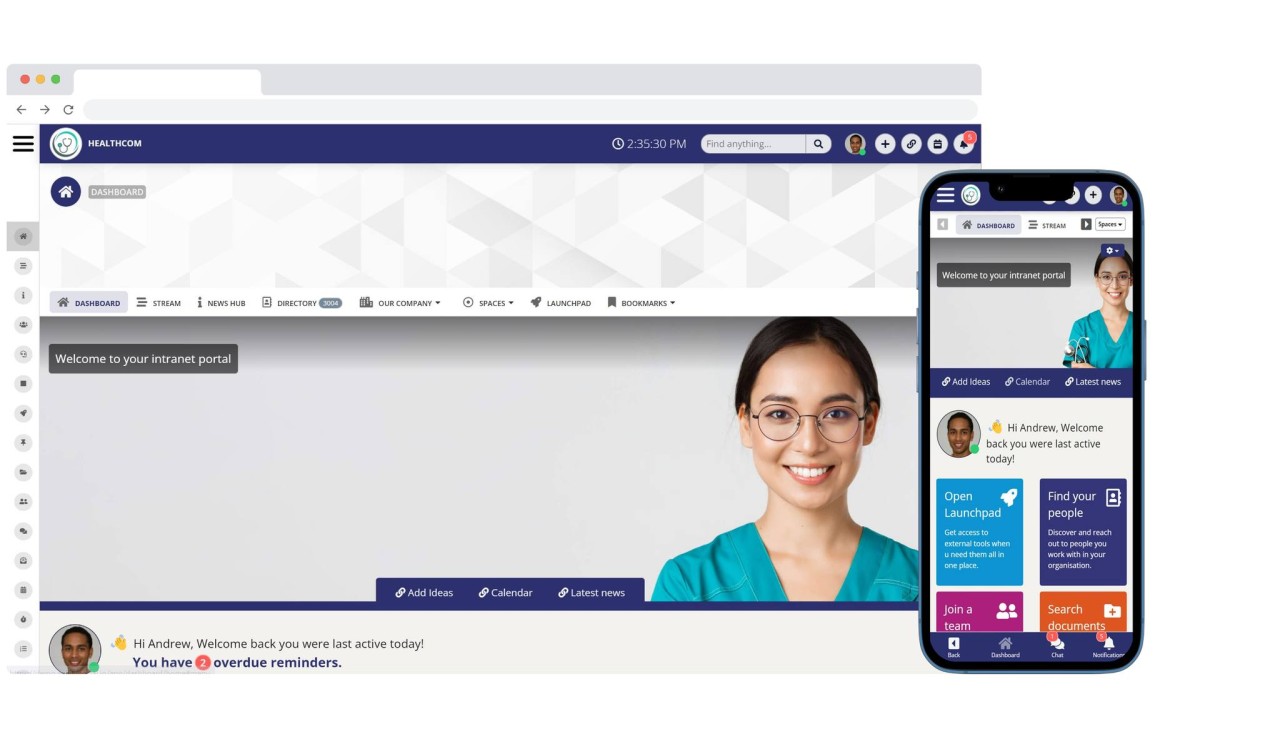Insight Blog
Agility’s perspectives on transforming the employee's experience throughout remote transformation using connected enterprise tools.
21 minutes reading time
(4106 words)
Choosing the right Remote Work Collaboration Tools in 2024
Remote Work Collaboration Tools are essential for dispersed teams. Discover the must-have remote collaboration tools your team needs for success.
Remote Collaboration Tools & Software
Prior to the onset of the COVID-19 pandemic, the use of tools and technology for remote work was primarily driven by teams collaborating across various office locations and time zones. In 2019, approximately 4.7 million U.S. employees engaged in remote work for at least half of the week, with 62% occasionally working remotely.
However, as more organizations transition to long-term work-from-home (WFH) arrangements, it becomes crucial for managers to leverage an array of remote work tools. These tools play a vital role in streamlining operations and keeping pace with rapidly evolving projects, campaigns, and initiatives.
Fortunately, there is a wide range of remote work collaboration tools and apps designed to enhance the efficiency of geographically dispersed teams in their teleworking setups. Some of these tools offer free versions, while others require a monthly or annual subscription for access to more advanced features and multiple user accounts.
Below, we provide insights into some of the top remote work tools for managers navigating the new normal of telecommuting in a post-pandemic world.
Additionally, we highlight remote collaboration tools specifically tailored for effective project management
The significance of remote work tools for your dispersed workforce
Work-from-home projects demand teams to be agile, focused on team building, and available for real-time collaboration. According to the U.S. Chamber of Commerce, providing your team with technology and productivity tools significantly enhances communication.
Effective communication extends beyond the specifics of ongoing projects, although that remains crucial. It also encompasses celebrating achievements, offering constructive feedback, and fostering engagement among team members.Compelling evidence supports the adoption of remote team tools. For example, GitLab, a remote-only company since its establishment in 2011, has 1200 employees working remotely across 27 countries. They rely on team collaboration and work-from-home software to establish a virtual workplace.
In addressing your team's productivity requirements, remote work tools can play a crucial role. To effectively manage a virtual team, ensure that their remote work collaboration tools possess features capable of supporting project management needs. Opt for versatile options that encompass most, if not all, of these functions to boost productivity and increase adoption rates of work-from-home software.
What are remote collaboration tools?
Remote collaboration tools encompass software, mobile applications, or online platforms designed to facilitate collaboration among team members, even when physically dispersed, with the common goal of achieving business objectives.
These tools play a pivotal role in fostering seamless communication and collaboration, bridging the geographical gaps between team members. In the evolving landscape of a post-pandemic world, these remote collaboration tools transcend the status of a mere convenience; they have become an indispensable resource for ensuring business success and maintaining operational continuity.
Expanding on this, the integration of robust remote collaboration tools is fundamental for businesses looking to adapt to the modern work environment, characterized by increased flexibility and distributed teams. These tools empower organizations to transcend traditional boundaries, enabling teams to work cohesively regardless of their physical locations. From real-time document collaboration to virtual meetings and shared project management platforms, these tools enhance connectivity, efficiency, and overall productivity.
Furthermore, as the business landscape continues to evolve, the strategic implementation of remote collaboration tools becomes a cornerstone for not only surviving but thriving in a competitive market. Companies that prioritize and invest in these tools demonstrate a commitment to embracing the future of work, ensuring that their teams can collaborate effectively, innovate, and drive success irrespective of geographical constraints.
The role of remote collaboration tools extends beyond mere facilitation; it is a key enabler for businesses seeking to navigate the complexities of a modern, dynamic work environment, fostering connectivity, resilience, and sustained growth.
Communication:
- Instant Messaging and Chat: Stay connected and respond promptly to questions and updates.
- Video Conferencing: Conduct virtual meetings, presentations, and team-building activities.
- File Sharing: Collaborate on documents, presentations, and other files in real-time.
Project Management:
- Task Assignment and Tracking: Assign tasks, set deadlines, and visually track progress.
- Workflows and Automation: Streamline repetitive tasks and enhance overall efficiency.
- Project Dashboards and Reporting: Access real-time insights into project progress and performance.
Collaboration Features:
- Shared Documents and Comments: Collaborate on documents and provide real-time feedback.
- Whiteboards and Online Brainstorming Tools: Capture ideas and engage in visual collaboration.
- Discussion Boards and Forums: Share knowledge, pose questions, and foster team discussions.
Additional Considerations:
- Integrations: Connect your collaboration tool with other essential tools such as calendars and email.
- Security and Privacy: Prioritize a tool that ensures robust data security and privacy measures.
- Ease of Use: Ensure the tool is user-friendly for all team members, regardless of technical expertise.
- Scalability: Consider your team's potential growth and select a tool that can adapt to evolving needs.
Follow us and access great exclusive content everyday: Follow us on Google News
The Remote work software features
If your teams are spread across different offices, countries, or continents, incorporating remote work tools is imperative.
However, selecting the right tool tailored to your company's needs can be challenging. Consider these three tips to assist you in identifying a tool that suits your requirements:
- Investigate the tools used by your competitors.
- Explore online user reviews for various tools.
- Seek referrals from your peers or former colleagues.
Begin by pinpointing the specific features essential for your team and check if they align with the offerings of the remote tool. Here is a compilation of common features to look for in remote work software:
- Flexible Work Environment -The ability to work from any location and device, ensuring team members can collaborate seamlessly by staying connected to the internet.
- Project and Program Management - Capability to manage multiple projects, programs, campaigns, and initiatives concurrently. This includes workload management, task assignment, and setting estimated deadlines.
- Team Messaging - Real-time messaging for internal teams to streamline communication, eliminating the need to sift through multiple emails, calls, or texts. Conversations are centralized and easily retrievable.
- Time Tracking - Integrated time tracking to monitor and manage employee productivity, especially crucial for companies billing clients based on hours worked.
- Cloud Storage - Secure, cloud-based document storage for geographically distant teams. This ensures a central repository for all official documents, promoting clarity and saving time.
- Data Security - Robust data security features to keep all company data 100% secure and protected from unauthorized access when stored in the cloud.
By prioritizing these features, you can make an informed decision when selecting remote work tools, enhancing collaboration, productivity, and data security for your dispersed teams.
What purposes do virtual collaboration tools serve?
Managing teams can be a demanding task, but with the aid of remote collaboration software, teams can efficiently plan workloads, organize tasks, and successfully execute projects.
Virtual collaboration tools serve various purposes, enabling teams to:
- Facilitate Real-time Communication - Engage with team members through real-time chat, screen sharing, messaging, or video calls, fostering seamless communication.
- Task Management and Time Tracking - Effectively manage project tasks and monitor time spent on work at daily, weekly, and quarterly intervals, ensuring efficient project progress tracking.
- Collaboration on Projects and Programs - Work collaboratively on specific projects and programs, promoting teamwork and enhancing overall project outcomes.
- Centralized File Access - Access shared files, folders, and documents conveniently stored in a central cloud location, ensuring easy availability and version control.
- Collaboration with Stakeholders - Collaborate with internal teams, customers, partners, vendors, and other external stakeholders through virtual meetings and video conferencing, fostering effective collaboration regardless of geographical locations.
- Enhance Business Continuity - Boost business continuity by providing flexibility for team members to work from anywhere, using laptops, desktop computers, smartphones, or tablets. This adaptability ensures uninterrupted workflow and accessibility.
You may also like: Best Apps for Employees: UPDATED 2022 – A Complete Guide
Benefits of Using Remote Collaboration Apps for Team Collaboration and Productivity
In the realm of remote work, effective communication and collaboration play pivotal roles in the success of dispersed teams. Remote collaboration apps serve as integral tools, providing centralized platforms for seamless communication, idea sharing, and project collaboration.
This not only enhances teamwork but also contributes to efficient decision-making.
Beyond communication, these apps offer streamlined project management features, contributing to enhanced productivity and team alignment. Let's delve into the key aspects of how remote collaboration apps bring about these improvements.
- Improved Communication and Collaboration - Remote collaboration apps establish a centralized hub where team members communicate, exchange ideas, and collaborate on projects. Real-time messaging and video conferencing features facilitate instant communication, fostering efficient decision-making and teamwork. Document collaboration tools enable simultaneous work on the same file, eliminating version control issues and enhancing the editing process. Additionally, comment and feedback features ensure comprehensive collaboration, giving everyone a voice in the project.
- Streamlined Project Management - Efficient project management is paramount for remote teams, and collaboration apps offer comprehensive project management features. These include task assignments, progress tracking, setting deadlines, and creating milestones, providing a structured framework for effective project management. Task management tools enable the assignment of tasks, setting priorities, and progress monitoring, ensuring accountability and alignment toward project goals. This streamlining of workflows enhances productivity and minimizes the risk of miscommunication or missed deadlines.
- Enhanced Productivity and Efficiency - Designed to boost productivity, remote collaboration apps offer seamless access to essential tools and resources. Integrated team collaboration features empower individuals to work on complex tasks, brainstorm ideas, and solve problems efficiently. These apps often integrate with other productivity tools, facilitating easy access to calendars, file storage, note-taking apps, and more. By eliminating the need to switch between multiple applications, remote collaboration apps streamline workflows, saving valuable time.
- Facilitated Virtual Teamwork - Building camaraderie and teamwork in remote settings can be challenging, but remote collaboration apps bridge this gap. Video collaboration software enables face-to-face meetings, strengthening personal connections and improving collaboration. Virtual teamwork platforms provide spaces for informal conversations, water cooler chats, and team-building activities, fostering a cohesive and inclusive work environment. These tools actively promote engagement, trust, and a sense of belonging within the remote team.
How to choose an online collaboration tool
Transitioning from an old collaboration tool to a new one poses challenges, as does the setup of a new tool. In reality, 69% of workers report wasting up to 32 days a year navigating through all their workplace apps.
Hence, it becomes crucial to select an online collaboration tool that not only facilitates a smoother transition for your employees but also enhances the efficiency of your tasks and communication processes.
Following comprehensive research, we have compiled six essential aspects to consider when choosing an online collaboration tool.Here they are choosing the right Remote Work Collaboration Tools in 2024:
1.Ease of use
Transitioning to a new tool is consistently a challenging process, often met with employee discomfort. This is primarily due to the learning curve associated with a new tool, demanding time and potentially hindering productivity.
Consequently, the market now places significant importance on the intuitiveness or ease of use of a tool. Online collaboration tool providers have begun recognizing this need. When selecting a tool, prioritize one that is easy to set up and user-friendly for your team. Ensure that the tool comes with reliable customer support, knowledge base guides, videos, and other resources to facilitate a quicker learning process.
2.Pricing
Cost plays a crucial role in the selection of a collaboration tool. Managing an organization involves financial considerations, necessitating prudent spending. Online collaboration tools offer a range of pricing plans, from free versions to those demanding a significant investment. Choosing the right pricing plan involves considering the following four points:
These four questions serve as a guide to help you narrow down and select the appropriate pricing plan.
- Does the plan provide all the features you require?
- How many team members will use it regularly?
- Does it align with your budget?
- Will it effectively address all your pain points and requirements?
These four questions serve as a guide to help you narrow down and select the appropriate pricing plan.
3.Customization capabilities
Teams often operate in diverse ways. While one member may work from the office, another might prefer the flexibility of working from home. Additionally, individual preferences can vary, such as one team member favoring a grid view for tasks while another prefers a spreadsheet layout.
Given these differences in preferences and work styles, it's essential to have an online collaboration tool that provides a multitude of customization options. This ensures that your team can tailor the tool to their specific needs, ultimately maximizing productivity.
4.Based on your business needs
While there are numerous high-quality online collaboration tools available in the market, the mere popularity or ranking does not guarantee the best fit for your business. Opting for the top-rated collaboration tool may not necessarily align with your organizational needs, presenting an additional challenge.
To avoid such pitfalls, take the proactive step of sitting down with your team members. Engage in discussions to identify all requirements and pain points, both technical and non-technical, that an online collaboration tool should address. Compare these needs with the features of the top contenders in the market and choose a tool that aligns seamlessly with your business requirements.
Furthermore, don't hesitate to test potential online collaboration tools.
Many reputable providers, such as AgilityPortal, offer free versions, demos, and trials. Ensuring compatibility with your business needs is essential before making a final decision.
5.Top-notch security
Regardless of how effective its features may be, a tool falls short if it lacks robust security measures to safeguard user information—this holds true for online collaboration tools as well. In a world where cybercrimes are on the rise, protecting sensitive information is paramount.
Therefore, comprehensive research on security measures is essential. It's advisable to explore user review sites, visit the official website of the tool, and inquire with their support team about the implemented security measures for clients. Understand the specific security features your business requires before selecting the appropriate online collaboration tool.6.Integrations
The primary objective of utilizing an online collaboration tool is to enhance the efficiency and coherence of your team's work and communication. In the organizational context, various tools like Google Drive and Zendesk are likely integral to your daily operations, contributing significantly to your workflow. Therefore, it is crucial to seek an online collaboration tool that seamlessly integrates with the key apps your organization commonly utilizes.
This integration holds transformative potential. Connecting these apps with your online collaboration tool can revolutionize your team's work, making it more seamless, streamlined, and structured. This integration has the power to save your team substantial time. Instead of the laborious process of manually managing multiple tools independently and repeatedly integrating them with your online collaboration tools, the provision for seamless integration can eliminate these unnecessary and time-consuming steps.
In essence, the integration feature becomes a game-changer, enhancing the overall efficiency and productivity of your team by simplifying their workflow and eliminating redundant processes.
The 3 Best Remote Work Collaboration Tools in 2024
How can tools for collaborating with remote teams benefit your team?
Tools designed for collaborating with remote teams significantly contribute to improving efficiency, communication, and overall productivity for teams working in dispersed or remote work settings.
Here is our pick on the top 3 Remote Work Collaboration Tools to try today.
#1.AgilityPortal
AgilityPortal functions as an extensive social intranet, also known as an employee communication app and a remote work collaboration tool. It effortlessly integrates collaboration, social networking, and communication, offering a unified solution for these aspects.
In the realm of remote work challenges, the last thing you want is an intranet complicating matters. AgilityPortal stands out as a comprehensive people platform, transforming your workforce dynamics. Customized to enhance engagement, it enables your team to connect, communicate, and collaborate seamlessly.
Unlike platforms such as Microsoft SharePoint and Meta Workplace, AgilityPortal provides a secure hub for storing, organizing, sharing, and accessing information across diverse devices. Whether your organization consists of 100 or 100,000+ employees, AgilityPortal proves to be a versatile solution.
As a top choice among remote work collaboration tools for employees, AgilityPortal is favored for its user-friendly interface, clean design, and simplified intranet launch process. It seamlessly brings together your entire workforce, applications, and information in one cohesive space.
In the realm of remote work challenges, the last thing you want is an intranet complicating matters. AgilityPortal stands out as a comprehensive people platform, transforming your workforce dynamics. Customized to enhance engagement, it enables your team to connect, communicate, and collaborate seamlessly.
Unlike platforms such as Microsoft SharePoint and Meta Workplace, AgilityPortal provides a secure hub for storing, organizing, sharing, and accessing information across diverse devices. Whether your organization consists of 100 or 100,000+ employees, AgilityPortal proves to be a versatile solution.
As a top choice among remote work collaboration tools for employees, AgilityPortal is favored for its user-friendly interface, clean design, and simplified intranet launch process. It seamlessly brings together your entire workforce, applications, and information in one cohesive space.
With AgilityPortal, all communications are securely consolidated for easy access anytime and on any device. Explore its virtual collaboration tools through a free trial and discover why it is the ideal fit for remote teams.
- Unified Social Intranet: AgilityPortal serves as a comprehensive social intranet, consolidating employee communication, collaboration, and social networking in one platform.
- Remote Work Solutions: Tailored to address the challenges of remote work, AgilityPortal provides solutions for seamless collaboration, communication, and engagement for distributed teams.
- Integration: The platform seamlessly integrates collaboration tools, social networking features, and communication functionalities into a single tool, streamlining workflow for users.
- Secure Information Hub: Unlike other platforms like Microsoft SharePoint and Meta Workplace, AgilityPortal offers a secure hub for storing, organizing, sharing, and accessing information across various devices.
- Versatility: Whether your organization is small or large, with 100 or 100,000+ employees, AgilityPortal is designed to be a versatile solution that can adapt to different organizational sizes and structures.
- User-Friendly Interface: AgilityPortal is known for its user-friendly interface and clean design, making it easy for users to navigate and utilize its features.
- Effortless Collaboration: Facilitating effortless collaboration, AgilityPortal empowers your workforce to connect, communicate, and collaborate effortlessly, fostering engagement among team members.
- Centralized Communication: All communication within AgilityPortal is securely stored in one place, ensuring easy access at any time and on any device.
- Simplified Intranet Launch: AgilityPortal simplifies the process of launching your intranet, connecting your entire workforce, applications, and information in one unified space.
- Free Trial: The platform offers a free trial, allowing users to explore its virtual collaboration tools and experience how it can best fit the needs of remote teams.
#2.Slack
Slack stands out as a reliable remote collaboration tool, offering a secure and free platform for effective communication within remote teams, as well as with external partners and customers. Its direct messaging system proves to be indispensable for staying organized and handling urgent tasks efficiently.
The creation of distinct channels for various topics or tasks by Slack simplifies the process of locating relevant conversations. However, as the volume of activities increases, managing multiple threads may lead to confusion and distract from meaningful work. To optimize Slack's effectiveness, consider integrating it with other collaboration tools or task management software. This integration ensures everyone stays informed about the latest team updates, enhancing overall coordination and productivity. Slack is an excellent choice if you're seeking the best free collaboration tools for remote teams.
- Organized Chat Channels: Slack's channels offer a structured way to organize conversations, keeping teams focused on specific topics. Channels can be public or private, depending on the desired level of access.
- File Sharing and Collaboration: Slack allows seamless sharing of files within the platform, facilitating collaboration on documents, presentations, and other content. Users can comment on shared files, track changes, and set up reminders for deadlines.
- Integrations and Apps: Slack integrates with a variety of third-party apps, such as Google Drive, Dropbox, Trello, and Asana. This connectivity streamlines workflows and extends functionality, including project management tools, task automations, and social media integrations.
- Powerful Search: Slack's search feature enables quick retrieval of any shared or discussed information, using keywords, message content, user, or channel.
- Mobile Accessibility: Slack is available on mobile devices, providing continuous connectivity and access to conversations from anywhere. The mobile app is well-designed for seamless communication and work on the go.
- Customization: Users can customize Slack by changing themes, adding emojis, and setting up custom notifications, creating a personalized and productive environment.
- Video Calls and Meetings: Slack offers voice and video calling capabilities, facilitating real-time conversations, scheduled meetings, and screen sharing for versatile remote collaboration.
- Security: Slack prioritizes security with industry-standard encryption, access controls, and the option to set up single sign-on (SSO) with existing identity providers.
- Scalability: Designed to meet the communication needs of teams of all sizes, Slack is scalable and can grow with your business as your team expands.
- Productivity Improvements: Slack serves as a central hub for communication, file sharing, and task management, improving productivity. It also integrates seamlessly with other productivity tools like calendars and project management apps.
#3.Confluence
Confluence stands out as a robust tool for remote collaboration, playing a crucial role in optimizing the efficiency of distributed teams through streamlined document and task management.
Beyond its core functionalities, Confluence serves as a dynamic platform for the exchange of knowledge and ideas, fostering seamless connectivity among team members.
In addition to its collaborative features, Confluence offers advanced functionalities including reporting, analytics, and automation, making a significant contribution to effective project management.
This versatile tool empowers remote workers to swiftly identify bottlenecks and inefficiencies, providing a visual representation of data that aids in informed decision-making.
Utilizing Confluence's robust features enables teams to work collaboratively and address challenges associated with remote collaboration. Furthermore, Confluence's integration with popular applications like Slack ensures uninterrupted connectivity, allowing users to stay linked regardless of their location.
- Powerful WYSIWYG Editor: Confluence's WYSIWYG editor simplifies the creation and formatting of documents, supporting tables, images, and multimedia. It also accommodates various plugins for added functionality, such as code formatting, mathematical notation, and Gantt charts.
- Version Control: Confluence tracks changes to pages, allowing teams to revert to previous versions if needed, ensuring everyone works with the most up-to-date information.
- Searchable Documentation: Confluence's search functionality enables teams to quickly locate necessary information, saving time and reducing frustration, especially in complex projects.
- Collaborative Editing: Multiple individuals can work on the same page simultaneously, facilitating the sharing of ideas and collaboration, particularly useful for documentation projects and brainstorming sessions.
- Spaces and Hierarchies: Confluence organizes pages into spaces, further structured into hierarchies, aiding in keeping information organized and easily accessible.
- Templates: Confluence provides various templates for different document types, such as meeting notes, product requirements, and project plans, saving time and ensuring consistent formatting.
- Integrations: Confluence integrates with Atlassian products like Jira and Bitbucket, as well as third-party applications, streamlining workflow and facilitating information sharing across different platforms.
- Mobile App: Confluence's mobile app allows teams to access and collaborate on projects from anywhere, particularly beneficial for distributed or remote teams.
- Accessibility: Designed with accessibility in mind, Confluence includes features like keyboard navigation, screen reader compatibility, and alternative text for images, ensuring usability for users with disabilities.
- Customization: Confluence can be customized to match an organization's branding and style, creating a consistent user experience and facilitating easier information retrieval for teams.
Make remote Collaboration a success with AgilityPortal
Certainly, managing remote workers introduces complexity, but implementing an intranet solution, such as AgilityPortal, proves instrumental in keeping remote teams engaged, well-informed, and productive. This, in turn, directly contributes to a positive impact on the bottom line. Don't overlook the importance of measuring success so that you can effectively communicate the benefits derived from your intranet implementation.
Virtual collaboration tools go beyond mere task completion; they often serve as the determining factor between project success and failure. Utilize the aforementioned remote work tools to effectively oversee teams in a virtual setting, enhancing productivity, communication, collaboration, and overall work culture.
Wrike ensures that your teams are positioned for project success. Features like time tracking, resource management, shared dashboards, and reporting simplify the process of achieving targets and staying on course. Break down projects into manageable tasks and establish workflows that optimize collaboration within remote teams.
Free ebook: How To Get Your Intranet Off The Ground
Wrapping up
In the contemporary landscape of remote work, unlocking team productivity and fostering effective communication are imperative.
The key to achieving this lies in the transformative capabilities of remote collaboration apps, enabling teams to flourish irrespective of geographical constraints. These collaboration software solutions encompass a range of features, including real-time collaboration, document sharing, video conferencing, and project management. Leveraging cloud-based software, such as leading remote collaboration apps and virtual collaboration platforms, ensures seamless integration and secure access across various devices.
For both small businesses and global teams, the choice of collaboration tools holds significant importance.Factors such as affordability, user-friendliness, scalability, and cross-platform compatibility should be considered to pinpoint the ideal fit for your team's requirements. Embracing the potential of remote collaboration apps is a pathway to unlocking your team's true capabilities and enhancing overall productivity.
Categories
Blog
(2592)
Business Management
(318)
Employee Engagement
(205)
Digital Transformation
(172)
Intranets
(119)
Growth
(118)
Remote Work
(61)
Sales
(48)
Collaboration
(37)
Culture
(29)
Project management
(29)
Customer Experience
(26)
Knowledge Management
(21)
Leadership
(20)
Comparisons
(5)
Ready to learn more? 👍
One platform to optimize, manage and track all of your teams. Your new digital workplace is a click away. 🚀
Free for 14 days, no credit card required.


















